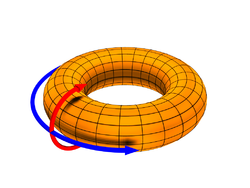
Toroidal and poloidal
Encyclopedia

Walter M. Elsasser
Walter Maurice Elsasser was a German-born American physicist considered a "father" of the presently accepted dynamo theory as an explanation of the Earth's magnetism. He proposed that this magnetic field resulted from electric currents induced in the fluid outer core of the Earth...
(1946) in the context of the generation of the Earth's magnetic field
Earth's magnetic field
Earth's magnetic field is the magnetic field that extends from the Earth's inner core to where it meets the solar wind, a stream of energetic particles emanating from the Sun...
by currents in the core, with "toroidal" being parallel to lines of latitude and "poloidal" being in the direction of the magnetic field (i.e. towards the poles).
The OED also records the later usage of these terms in the context of toroidally confined plasmas, as encountered in magnetic confinement fusion
Magnetic confinement fusion
Magnetic confinement fusion is an approach to generating fusion power that uses magnetic fields to confine the hot fusion fuel in the form of a plasma. Magnetic confinement is one of two major branches of fusion energy research, the other being inertial confinement fusion. The magnetic approach is...
. In the plasma context, the toroidal direction is the long way around the torus, the corresponding coordinate being denoted by z in the slab approximation or
 or
or  in magnetic coordinates; the poloidal direction is the short way around the torus, the corresponding coordinate being denoted by y in the slab approximation or
in magnetic coordinates; the poloidal direction is the short way around the torus, the corresponding coordinate being denoted by y in the slab approximation or  in magnetic coordinates. (The third direction, normal to the magnetic surfaces, is often called the "radial direction", denoted by x in the slab approximation and variously
in magnetic coordinates. (The third direction, normal to the magnetic surfaces, is often called the "radial direction", denoted by x in the slab approximation and variously  ,
,  , r,
, r,  , or s in magnetic coordinates.)
, or s in magnetic coordinates.)Toroidal and Poloidal Coordinates
As a simple example, consider an axisymmetric system with circular, concentric magnetic surfaces (a crude approximation to the magnetic field geometry in an early TokamakTokamak
A tokamak is a device using a magnetic field to confine a plasma in the shape of a torus . Achieving a stable plasma equilibrium requires magnetic field lines that move around the torus in a helical shape...
) and denote the toroidal angle by
 , and the poloidal angle by
, and the poloidal angle by  .
.Then the Toroidal/Poloidal coordinate system relates to standard Cartesian Coordinates by these transformation rules:



See also
- Toroidal coordinatesToroidal coordinatesToroidal coordinates are a three-dimensional orthogonal coordinate system that results from rotating the two-dimensional bipolar coordinate system about the axis that separates its two foci. Thus, the two foci F_1 and F_2 in bipolar coordinates become a ring of radius a in the xy plane of the...
- Zonal and poloidalZonal and poloidalIn magnetic confinement fusion the zonal direction primarily connotes the poloidal direction , the corresponding coordinate being denoted by y in the slab approximation or θ in magnetic coordinates...
- Poloidal – Toroidal DecompositionPoloidal toroidal decompositionIn vector analysis, a mathematical discipline, a three-dimensional solenoidal vector field F can be considered to be generated by a pair of scalar potentials Ψ and Φ:where k is a unit vector....
- Zonal flow (plasma)Zonal flow (plasma)In toroidally confined fusion plasma experiments the term zonal flow means a plasma flow within a magnetic surface primarily in the poloidal direction...

